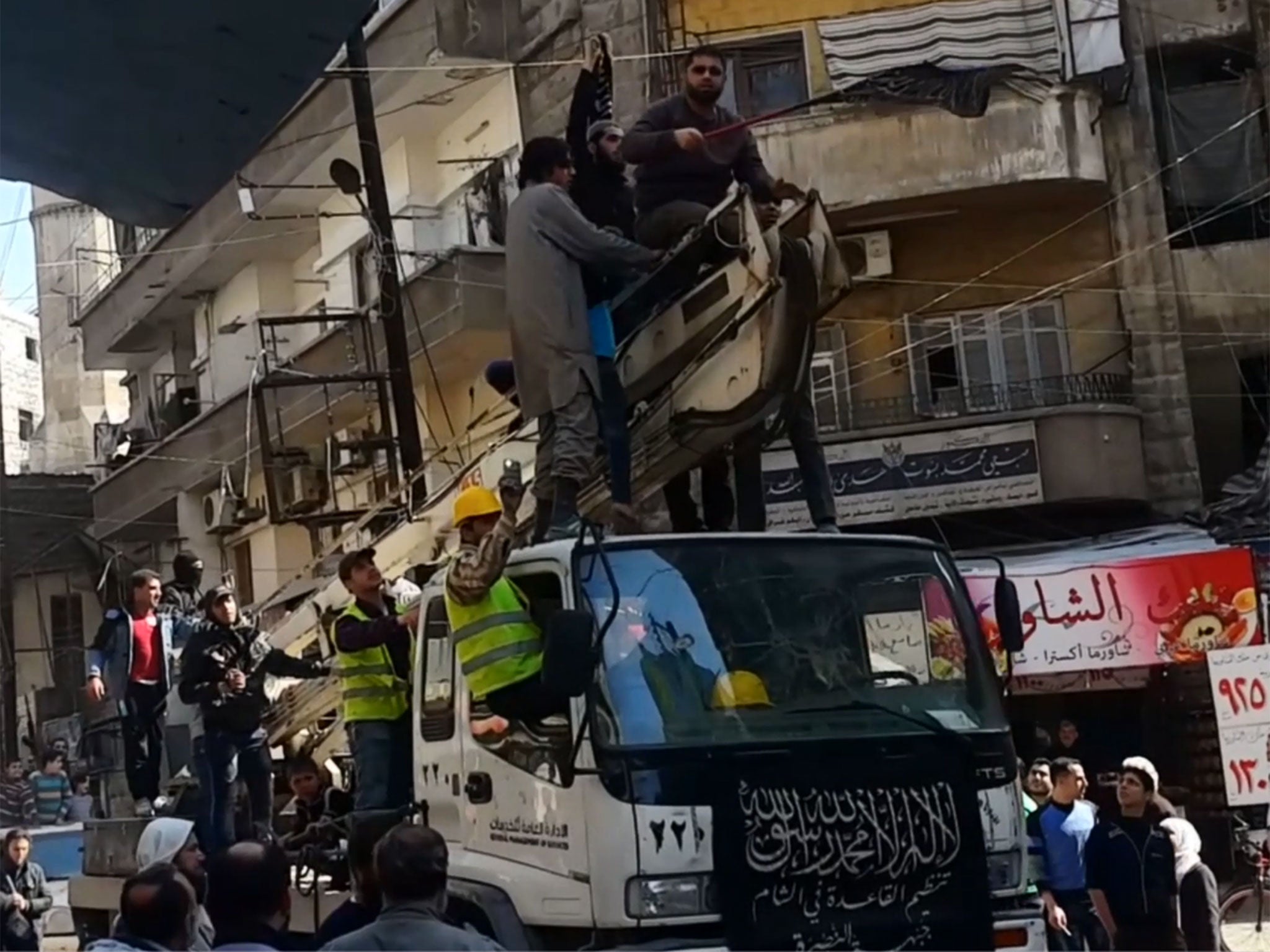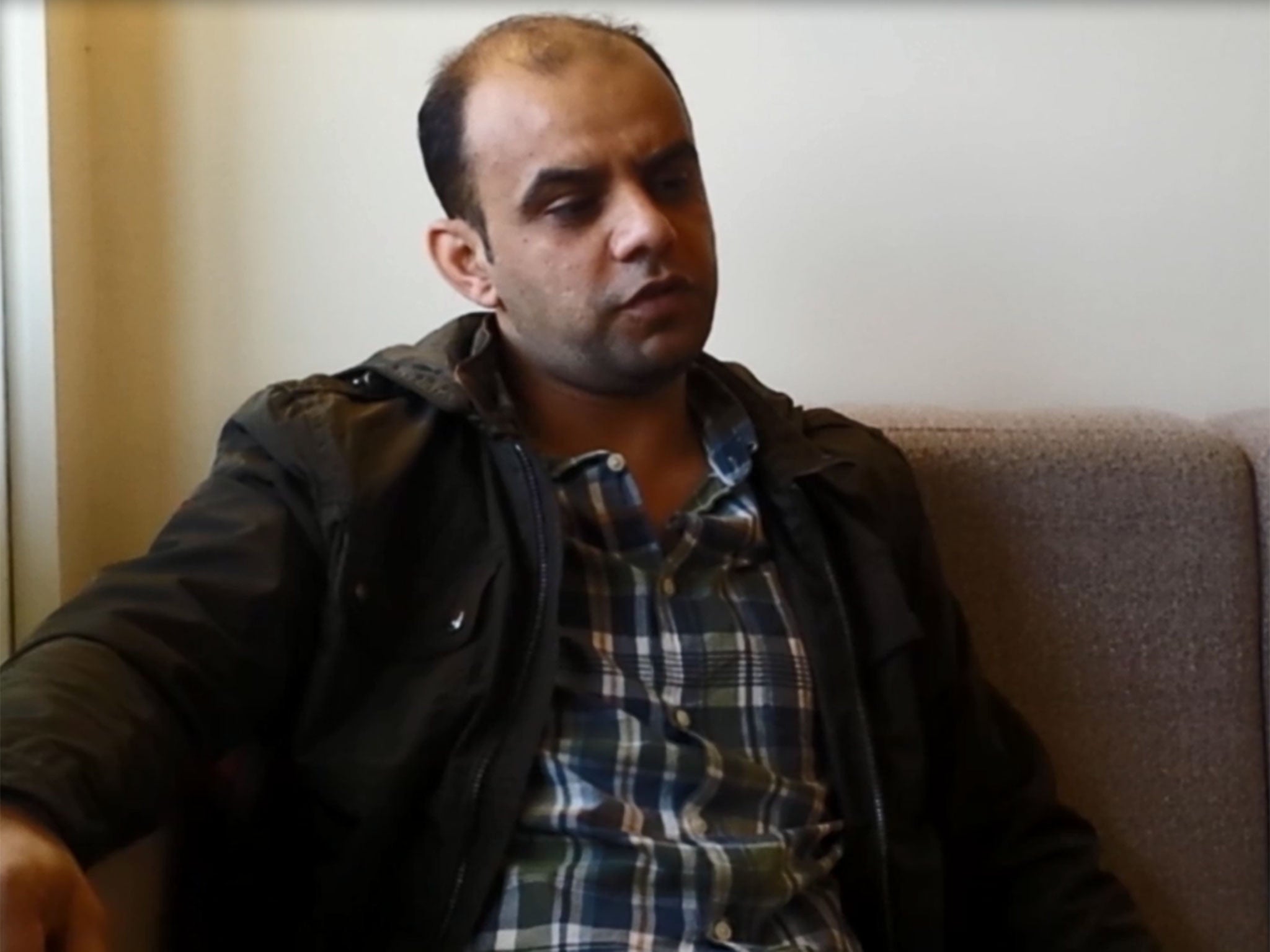Inside Aleppo: Syrian activists reveal kidnap and torture at hands of al-Nusra extremists
Exclusive: Two moderates speak to Kim Sengupta to describe how anti-Assad Islamists are turning on Syria's own children

Rayan was smashed in the face with a rifle butt and flung head first down concrete steps. Then he was hung from the ceiling by his wrists and beaten. Even then, the torture was not over: it stopped only when he fainted from the excruciating pain of being placed in a tyre while his legs were twisted and wrenched with a stick.
The 37-year-old interior decorator and judo trainer had been among the first to join the protest movement against Syria’s President, Bashar al-Assad. But the torture inflicted on him was not by the regime. It was by rebels supposedly on his side – another grim example of how Syria’s revolution is now consuming its own children.
Rayan is the nickname of Mohammed Oun, a well-known civil rights campaigner in northern Syria. He was held captive by Islamist extremists after taking part in the first large-scale demonstration inside rebel-held Syria against groups like Isis and Jabhat al-Nusra, held by people protesting against their vicious rule in the city of Aleppo.
Speaking in the safety of a town just across the Turkish border, Rayan described how the extremists attacked that brave demonstration, held in the first week of April. He told me of the mounting despair among those who had seen their revolution against the Assad regime hijacked, with the ideals for which they had sacrificed so much now lost. He also spoke of his intention to go back to Aleppo, despite the risks this would entail.
I had first met Rayan in Aleppo during the fierce battle in the summer of 2012 for the country’s richest and largest city. Two Syrian activists and I had gone to pick up Jim Foley and Nicole Tong, friends and fellow journalists, who were staying with Rayan at his home in the Bustan al-Qasr district, an area taken over by regime forces.
I had worked alongside Foley and Tong, covering a number of wars. Foley was kidnapped and murdered on a subsequent visit to Syria, the first of six foreign hostages to be beheaded by “Jhadi John” – the Londoner, Mohammed Emwazi, who has become the grotesque star of the organisation’s slick “snuff” videos. Foley had been kidnapped along with the British photographer, John Cantlie, in autumn 2012. A little later, Tong visited Rayan in Aleppo and told him what had happened.

Rayan, softly spoken and good humoured, recalled his own concerns about Foley. “Criminal gangs were kidnapping people and selling them to groups like Daesh [Isis] who were looking for Western people,” he said.
“We knew how violent they were, what they might do. At the time we thought – we hoped – something will be done and Jim will be freed. We were very grateful for foreign journalists coming to the free part of Syria to show the terrible things going on. It was shocking that they and aid workers were being taken prisoner. We were protesting against the way some of these extremist groups were behaving.”
Rayan searched long and hard for Foley but he, along with Cantlie, had been passed repeatedly from one group to another. Later Rayan saw the video of Foley’s death. “It showed what had happened to our revolution. The only foreigners the extremists wanted here were those who would take part in their jihad. Local people in Aleppo were also suffering badly in the hands of these people and we felt we must keep speaking up – we must protest.”
But that came at a cost. Rayan had previously been abducted by the al-Qaeda affiliate, Jabhat al-Nusra – the first time, in November 2013, after he and others objected to their treatment of anyone questioning their version of sharia law. He was subjected to one of their favourite forms of torture, the “aeroplane”, in which victims are suspended from the ceiling and beaten.

The activist was released after a few days with a warning. At the time the hardliners did not worry about liberals like Rayan too much: they were on a roll, extending their fiefdom as the Western-backed Free Syrian Army lost ground, men and influence. Al-Nusra and Isis were sometimes in alliance, sometimes fighting each other.
By the beginning of this year, most moderate activists in opposition areas had been forced to flee, been imprisoned or killed. But those who remained decided they must take a stand for the original values of the revolution before it was too late. A demonstration was to be staged in Aleppo, with the organisers declaring that all the differing groups of the revolution would be welcome.
Bari, another activist, said: “The aim was to re-establish the ideal of the revolution – democracy, equality and a united Syria. We could not let this continue, the extremists oppressing the people while Bashar continues to do his own oppression. We wanted there to be a debate about the course of the revolution.”
Bari’s own home town, al-Bab, around 20 miles from Aleppo, was a microcosm of what happened. The moderate rebels took control first; then al-Nusra, which is allied to al-Qaeda, established a presence, and finally came occupation by Isis, and with it a savage regime of shooting, hanging and flogging.

Rayan said that at the Aleppo demonstration at first, there was laughter, camaraderie and cries of “freedom” from the crowd of around 300, just like the early days of the revolution. But then al-Nusra men appeared in trucks, along with some of their supporters. These included members of Hizb ut-Tahrir, a radical Islamic group with an extensive network in the UK. The organisation in the UK has denied any links with Al-Nusra.
Al-Nusra responded to calls for tolerance with their swords, chopping down the green, white and black flags of the revolution. They then turned their swords on the protesters. One of their leaders who tried to calm the situation was screamed at by one of his own fighters, waving a Kalashnikov assault rifle: “You have become an atheist!”
The activists decided to complain about the attacks to the sharia court and Rayan was chosen as their spokesman. As he left court the next day, he was ambushed by three masked men and knocked down with rifle butts. Blindfolded, he was taken to what he thought was a warehouse an hour’s drive away.
Rayan was put in a tiny cell. He then heard a whisper, the prisoner next door had gouged a hole in the wall and desperately wanted to get a message to the outside. He was an officer in the Farouq Brigade, a moderate group which had been accused of killing a leader of a Salafist faction, Dawa al-Islamiyah.
Since his second kidnapping, Cantlie remains the last known Western hostage of Isis. He has been appearing, under duress, to appear in the group’s propaganda videos.
Rayan decided there was no point in being apologetic during his interrogation. “They knew my views, they wouldn’t have believed if I had told them that I had suddenly changed my mind and agreed with them. In any case they brought along an informer who accused me of spying on al-Nusra, being a kuffir [an unbeliever], all kinds of things. So, I was found guilty very quickly.
“At that point the man questioning me took off his mask. Now, I began to feel frightened: if he was willing to show his face to me, I thought for the first time that I wasn’t going to get out alive. There was a tremendous feeling of hopelessness, but I knew I must fight against it.”
Guards were called and ordered that the “kuffir” be punished. Rayan was thrown down the stairs, his head bouncing on the steps. Then the vicious ritual began: he was strapped to a bed and whipped with a length of cable. Then came the “aeroplane”, more beating. “It went on and on, but it was probably about two hours,” he said. “I tried to shut my mind, but the pain gets through; when I thought it was over, I realised they had other plans for me.”
Rayan was placed inside a tyre and a stick was used to twist his legs. “This was worse than anything before, and I began to pass [out]. As I was fading away I could hear one of them complaining that I was fainting too soon.”
He was awakened with water thrown over him, and then driven back to Aleppo in a van, his face forced down on the floor with a boot on his head. He was produced before a sharia court. But if al-Nusra had expected a swift sentence of judicial killing they were disappointed: fighters from moderate rebel militias were there, having heard what had happened.
When al-Nusra officials accused Rayan of inventing his torture account, he took off his shirt to show the marks of whipping on his body, and then his trousers to reveal horrific injuries to his legs. “The judge was a good judge, and he said I must be freed immediately. That shows there are still people who will stand up to extremists – it is something we can build on,” he insisted.
Now Rayan says he will be going back to Aleppo soon. The dangers are obvious, but he says: “We need to continue fighting back. These people have gained so much power because other people have been afraid to speak up. But the protest march showed people are prepared to stand up for the revolution despite the dangers: we have no other choice.”
Join our commenting forum
Join thought-provoking conversations, follow other Independent readers and see their replies
Comments